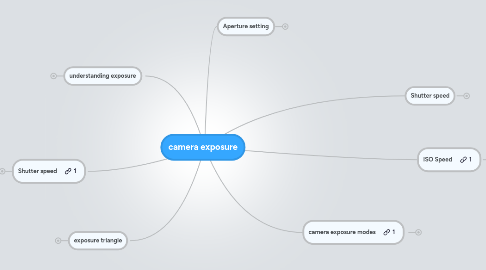
1. Shutter speed
1.1. "exposure time"
1.2. controls the camera sensor for incoming light through the camera lens
1.3. by number
1.3.1. simple
1.3.2. correlates 1:1 with the amount of light entering the camera
1.3.3. ex. when the exposure time doubles the amount of light entering the camera doubles.
1.4. powerful tool for freezing or exaggerating the appearance of motion
1.4.1. ex. sharp hand held shot
1.4.1.1. experiment and look at results on you camera rear LCD screen at full zoom
1.4.1.2. if blurred you either need to increase shutter speed, keep hands steadier, or use a tripod
2. camera exposure modes
2.1. Auto (green rectangle)
2.1.1. selects all exposure settings automatically
2.2. Program(p)
2.2.1. selects aperture & shutter speed autmomatically
2.2.2. choose a corresponding ISO speed & exposure compensation
2.2.3. some cameras "p" can be as a hybrid of AV & TV modes
2.3. Aperture Priority (Av)
2.3.1. specify the Aperture & ISO
2.3.2. camera metering determines the corresponding shutter speed
2.4. Shutter priority(tv)
2.4.1. specify the shutter speed & ISO
2.4.2. metering determines the corresponding aperture
2.5. Manual(M)
2.5.1. specify the aperture, ISO, & shutter speed
2.6. Bulb(B)
2.6.1. useful for exposure longer than 30 sec.
2.6.2. you specify aperture & ISO
2.6.3. shutter speed determined by remote release switch or the time you press the shutter button 2wice
2.7. influence how aperture, ISO, and Shutter speed are chosen to certain exposure
2.8. Av, tv, M -> "creative modes "or "auto exposure modes"
2.9. have several preset modes
2.9.1. portrait
2.9.1.1. picks a high f-stop to ensure large depth of field
2.9.1.2. compact cameras often set their focus distance to distant objects or infinity
2.9.2. landscape
2.9.2.1. ensures the shallowest possible depth of field
2.9.2.2. picks lowest f-stop value possible for given exposure.
2.9.3. sports
2.9.3.1. achieves as fast a shutter speed as possible given exposure- 1/250 sec or faster
2.9.3.2. low f-stop
2.9.3.3. increasing ISO to have fast shutter speed
2.9.4. night mode
2.9.4.1. permits shutter speed which are larger than ordinarily allowed for hand held shots
2.9.4.2. increases ISO speed to near its maximum available value.
2.10. camera metering system
2.10.1. relied for the preset modes in order to know proper exposure
2.10.2. can be fooled so be aware
3. ISO Speed
3.1. determines the sensitivity of the camera of incoming light
3.2. correlates 1:1 with how much exposre increases or decreases
3.3. always desirable unlike Aperture and shutter speed
3.4. higher ISO speed dramatically increase image noise
3.5. minimum value-> increased if desired aperture and shutter speed isn't obtainable
3.6. common speeds: 100, 200, 400, & 800
3.7. compact cameras ISO speed ranges 50-200 produces low image noise.
3.7.1. with digital SLR cameras range of 50-800 is good
3.8. LOW and HIGH ISO speed image noise is also knwon as "film grain"
4. Aperture setting
4.1. controls which light can pass thorugh the camera lens
4.2. specifically called f-stop
4.2.1. area of opening increases as the F-stop decreases
4.2.2. photography slang-> "stopping down" or "opening up" reffered to increasing & decreasing the f-stop value
4.2.3. by numbers
4.2.3.1. f-stop value halves, the light collecting area quadruples
4.2.3.2. ex. aperture setting: f/22, relative light: 1x, examaple shutter speed 16 sec; aperture setting: f/16, relative light: 2x, example shutter speed: 8 sec
4.2.4. all standard options in any camera
4.3. depth of field
4.4. lower F-stop value correlates with a shallower depth of field
4.4.1. ex 1. wider aperture: f/2.0,low f-stop #, shallow depth of field
4.4.2. ex 2. Narrow aperture f/16, high f-stop #, large depth of field
4.5. shutter values are not always possible in increments of exactly double or half another shutter speed, but is always close enough that you could barely tell the difference
5. understanding exposure
5.1. good exposure is like collecting rain in a bucket
5.1.1. collecting rain
5.1.1.1. cant control rainfall
5.1.1.2. can control: the bucket size, the time you leave the bucket in the rain, and the amount of rain you want to collect
5.1.2. in photograhy
5.1.2.1. can't control natural light
5.1.2.2. can control the width, time and quantity in the settings of aperture, shutter speed and ISO speed
6. exposure triangle
6.1. aperture
6.1.1. controls opening for the incoming light
6.2. shutter speed
6.2.1. control duration
6.3. ISO Speed
6.3.1. controls sensitivity
7. Shutter speed
7.1. control duration of light
7.2. control sensor for light
7.3. "exposure time"
7.4. simple
7.5. tool to freeze or exaggerate the appearance of motion
7.6. correlate 1:1 with the amount of light entering camera
7.6.1. ex. exposure time doubles->amount of light entering camera doubles
